Digital Embodiment: Unleashing Kinesthetic Learning Through VR
In a world moving rapidly towards digital transformation, the role of Virtual Reality (VR) has emerged as a powerful tool for fostering kinesthetic learning in online environments. This instructional method shifts the focus from conventional teaching to a more immersive experience, engaging students in a way that traditional classrooms struggle to achieve. Let's explore how VR is revolutionizing education and enabling students to learn by doing, thus enriching their educational journey.
The Evolution of Online Education
Online learning has undergone a remarkable transformation since its inception. No longer confined to static text and videos, the online education landscape now offers interactive experiences that replicate real-world scenarios. As technology continues to evolve, the demand for innovative tools to enhance learning is greater than ever. Enter Virtual Reality—an exciting frontier that combines the interactivity of gaming with educational rigor.
VR essentially creates simulated environments, allowing learners to engage with the material actively. This is particularly beneficial for kinesthetic learners—those who thrive on hands-on activities—as they experience lessons in a way that aligns with their learning preferences. A study conducted by the University of Maryland found that students who used VR in their studies retained information more effectively, hinting at the potential longevity of bizarre facts acquired through direct experiences.
Understanding Kinesthetic Learning
Kinesthetic learning, or tactile learning, refers to a learning style where individuals learn best through physical activities. These learners prefer doing over simply listening or watching, effectively engaging their motor skills to reinforce their understanding. Integrating kinesthetic elements into online education has been historically challenging, but VR offers an unparalleled opportunity to bridge that gap.
Kinesthetic learning influences numerous fields—from science experiments in physics to ballet training in performing arts. This method helps students connect abstract concepts to tangible experiences, boosting memory retention, engagement, and even enjoyment in learning. With the rise of VR, educational platforms can now tailor courses specifically for kinesthetic learners, harnessing their natural strengths.
The Benefits of Digital Embodiment
-
Immersion: Virtual Reality immerses students in rich environments, engaging their senses and allowing them to manipulate objects and navigate through spaces. This 360-degree experiential approach cultivates a strong emotional connection to the content being learned.
-
Active Engagement: VR encourages students to engage in their learning actively. Unlike passive video lectures, platforms that incorporate VR require learners to make decisions, overcome challenges, and explore scenarios first-hand, fostering a deeper understanding of the subject matter.
-
Safe Learning Environment: Errors are part of the learning process, and VR provides a safe space for students to make mistakes without real-world consequences. This crucial aspect helps them develop resilience as they experiment and practice skills repetitively.
-
Personalized Learning Pace: With VR, students can progress at their own pace, making learning less intimidating. They can revisit complicated topics or skip ahead, fostering an environment of confidence and self-directed inquiry.
-
Development of Soft Skills: Many courses comprising VR training are designed to include either real-time feedback or peer interaction, thus helping students develop crucial soft skills like communication, teamwork, and problem-solving—skills essential for future employment.
How VR is Transforming Specific Educational Fields
1. Medical Training
VR simulations have proven revolutionary in medical education. Trainees can perform virtual surgeries or interact with virtual patients, allowing for practical experience that would be impossible to replicate in traditional classrooms. As highlighted in an article by Harvard Medical School, this kind of training not only enhances surgical skills but also boosts confidence in decision-making during real-life medical scenarios.
2. Science and Mathematics
Consider an online course in biology where students explore the intricate anatomy of the human body. Using VR, learners can "walk through" the human circulatory or nervous system, visualizing the spatial relationships between organs and tissues. This engagement solidifies concepts that would otherwise remain abstract.
3. History and Social Studies

Imagine stepping into a simulated historical event. VR allows learners to experience significant moments in history, such as walking through ancient Rome or participating in pivotal battles. This innovative approach revitalizes history lessons, making them vivid and impactful.
Designing Effective VR Learning Experiences

Creating effective VR educational experiences requires thoughtful design principles. Here are some key considerations for educators and course designers:
-
Define Learning Objectives: Clarifying what learners should achieve sets the framework for the rest of the design process. Align activities within the VR experience with these objectives.
-
Interactive Simulations: Integrate authentic, skill-based activities that reflect real-world applications. Given that immersive learning through VR is all about action, the simulations must encourage participation.
-
User-Friendly Interface: A major obstacle in VR education is ensuring a seamless user experience. The interface should be intuitive to prevent learners from feeling overwhelmed or distracted by technical difficulties.
-
Feedback Mechanisms: Utilize feedback within the VR experience to guide student learning. This can include hints, scoring systems, or the option for VR peer interaction.
-
Incorporate Collaborative Elements: Foster social interactions among learners. Group activities in VR can enhance social learning, build networks, and facilitate teamwork—a key skill in today’s job market.
Addressing Challenges in VR Education

Despite its advantages, VR in education faces challenges such as accessibility and technology costs. Not all students have access to VR headsets or high-speed internet, which can create inequalities. Furthermore, the development of quality VR content requires considerable investment and expertise. Here are some strategies to overcome these hurdles:
-
Affordable Options: Many organizations and educational institutions are exploring ways to provide state-of-the-art VR experiences via mobile devices or lower-cost headsets without compromising quality.
-
Hybrid Approaches: Incorporating some aspects of VR without needing complete immersion can still offer the benefits of kinesthetic engagement. Mixed Reality (MR) or Augmented Reality (AR) tools can often serve as effective alternatives.
-
Professional Development for Educators: Educators require training not only to use VR technology effectively but also to integrate it into their curricula without losing sight of learning goals. Many platforms already offer resources for teacher training to help build confidence.
Case Studies: Success Stories

There are already numerous inspiring examples of institutions successfully harnessing VR for education. One notable case is the University of Illinois' "VR in Education research initiative," which aims to study the integration of VR in various academic disciplines. Their findings show remarkable engagement levels and distinct improvements in student performance.
Another example is the collaboration between Google and their partner schools, enabling students to take immersive field trips worldwide while remaining in their classrooms. By leveraging the VR experience, learners engage with ecosystems, historical sites, and different cultures right at their desks.
Embracing the Future of Learning

The future of education rests on the collaboration between technology and pedagogy. Embracing digital embodiment will mean refining our understanding of diverse learners and their needs. This continually evolving educational landscape is a thrilling opportunity to create more engaging, effective learning experiences that can captivate students like never before.
Leaning towards VR applications can spark lifelong learning, motivate students, and prepare them for real-world challenges. As we break the mold of traditional educational systems and look towards innovative models, we should also consider how we can harness these advancements responsibly and inclusively.
Next Steps
Ready to dive into the world of Virtual Reality in education? Explore platforms that offer VR courses tailored to your interests and learning objectives. Engage with peer communities to exchange ideas and get the best out of your experiences. If you're an educator, consider self-training resources that help you integrate VR into your course offerings.
For a deeper understanding of how to improve your online courses, check out this insightful blog post on harnessing neurodiversity in online courses or investigate how AI is shaping the future of online education.
The promise of VR in education is just beginning to unfold. By participating in this educational revolution, you can help shape the future of learning for generations to come.









